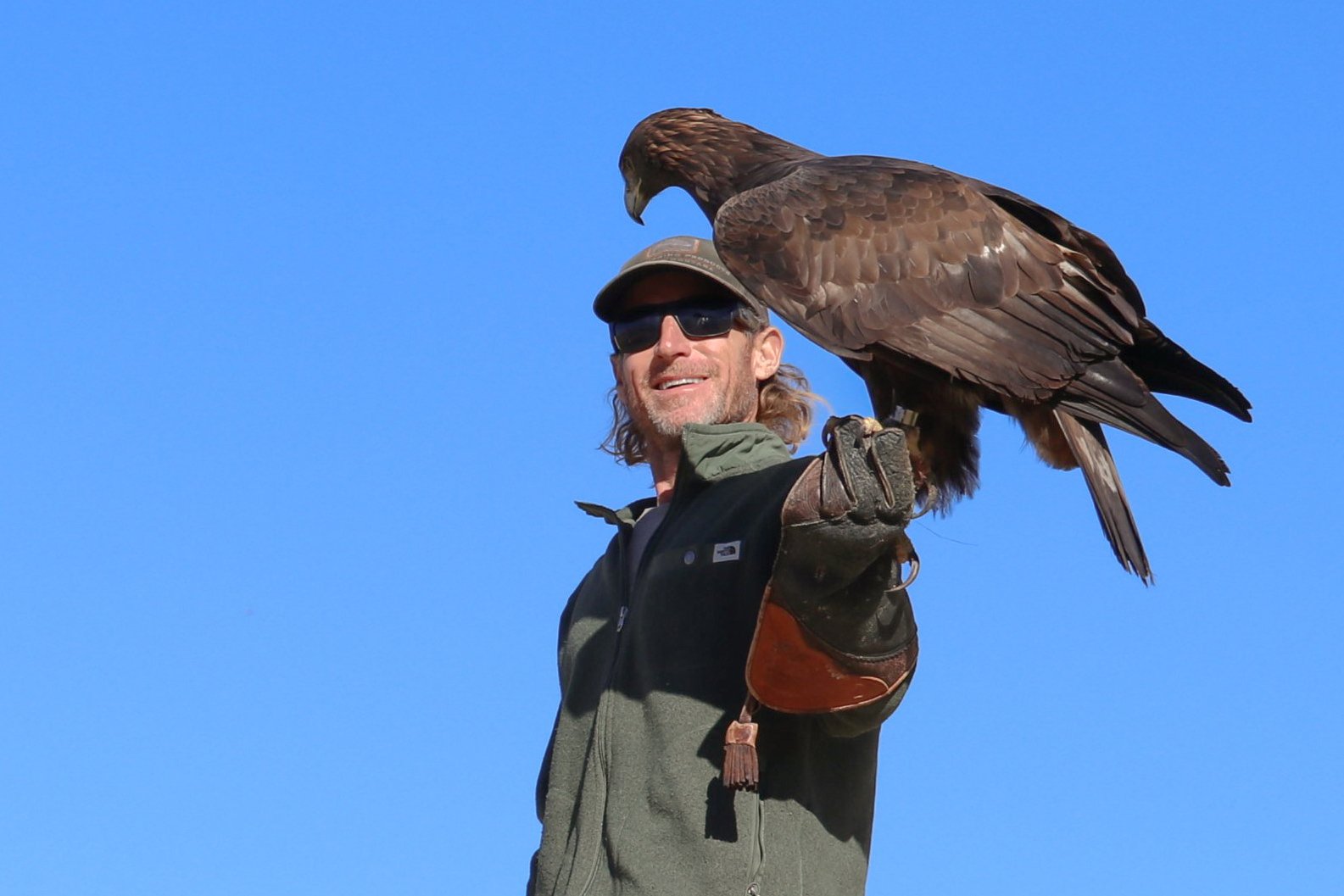A Golden Eagle’s Journey Back to the Wild at Wind Wolves Preserve
Mark Schwaiger releases golden eagle at Wind Wolves Preserve / photo by Megan Ellington
On Tuesday, December 17th, the majestic wings of a golden eagle once again caught the wind as she soared high over Wind Wolves Preserve. This wasn’t just any eagle — it was Mary, a golden eagle who had spent years rehabilitating after an injury and was now returning to the wild. Her release at Reflection Pond marked the culmination of a dedicated rehabilitation process, as well as the beginning of a new chapter in her life in the wildlands of California.
The Road to Recovery
Mary’s recovery story began in 2020, when a hiker discovered her injured in the foothills of Orange County. The young eagle, just a fledgling, had a broken leg. She was brought to the Orange County Bird of Prey Center, where her injuries were treated by Dr. Scott Weldy. After her leg healed, the next step was to prepare her for release into the wild.
That’s where Mark Schwaiger, a seasoned master falconer with 25 years of experience, stepped in. Mark has spent the last decade rehabilitating golden eagles, and his expertise in training birds for release is unparalleled. For Mary, this meant a three-year process of building trust, learning essential survival skills, and getting into peak physical condition for her return to the wild.
“Typically, the rehabilitation process takes about two years,” Mark explains. “But with Mary, it took a little longer — about three years. This was due to the wild rabbit virus that wiped out 90% of the local rabbit population for a year, which delayed her hunting training. But with patience and persistence, we were able to prepare her for life in the wild.”
The Rehabilitation Process
Mark’s method of rehabilitation is unique and intensive. It begins with developing a relationship with the bird, feeding her off his glove and teaching her basic flight maneuvers. Once Mary was flying well enough to hunt, Mark used a remote-controlled truck to simulate a wild rabbit escaping from her, getting the eagle into shape for real-life prey.
“When she could consistently catch wild jackrabbits, I knew she was getting close to being ready for release,” Mark says. “The final step was teaching her to soar. Eagles need to be able to fly for long distances, and I took her to a windy hilltop to practice soaring for at least 45 minutes, which is a natural skill for an eagle.”
Wind Wolves Preserve: A Safe Haven for the Eagle
Choosing Wind Wolves Preserve for Mary’s release wasn’t an accident. The Preserve, with its vast open spaces and rich wildlife, provides a perfect habitat for the golden eagle. Mark knew that the area was teeming with prey, such as rabbits and ground squirrels, and that it also offered the kind of remote environment where the eagle could thrive without human interference.
“The mountain range at Wind Wolves is huge, and there is already an eagle population in the area. It’s the perfect place for her to find her own territory, maybe even a mate, and start a new life,” Mark adds.
Wind Wolves Preserve offers the ideal space for eagles to adapt and thrive, providing a vast, protected environment where they can live free from human disruption.
A Symbol of Resilience
Mary’s release is a powerful reminder of the resilience of wildlife and the critical role top predators like the golden eagle play in maintaining ecosystem balance. By hunting rabbits and other small mammals, golden eagles help regulate prey populations, supporting the health of the entire ecosystem.
“The release of this golden eagle is not just about one bird — it’s a symbol of the health of our environment and the importance of protected spaces like Wind Wolves Preserve,” says Carolina Ruiz, Outdoor Education Coordinator at Wind Wolves Preserve. “This is a place where wildlife can live and thrive without the pressures of human encroachment.”
Although no tracking or monitoring will be conducted after Mary’s release, Mark is confident that she will do well in the Preserve. “She’s strong, skilled, and ready,” he says. “The eagle population in the area will give her the opportunity to meet others and eventually start a family.”
The Bigger Picture: Conservation and Community Impact
While the release of the eagle wasn’t part of a large-scale conservation program, it highlights the importance of community efforts in wildlife rehabilitation and conservation. Partners like the Orange County Bird of Prey Center and Mark Schwaiger’s expertise in falconry all play a critical role in returning animals to the wild.
“This release is a direct result of collaboration between wildlife rehabilitators, conservationists, and protected spaces like Wind Wolves Preserve,” says Landon Peppel, Deputy Director of Conservation & Restoration Programs for The Wildlands Conservancy. “It’s a beautiful example of how a community can come together to make a real difference for wildlife.”
Looking Forward
As for the future, Wind Wolves Preserve remains a key player in the ongoing efforts to protect and restore wildlife in California. The successful release of this golden eagle reinforces the value of conserving open spaces and providing safe habitats for species at risk.
“The golden eagle is just one example,” says Mark. “There’s so much work still to be done to protect these incredible creatures, but seeing her take flight today gives us hope for the future. It reminds us that with patience, dedication, and the right partnerships, we can help these birds — and many others — find their way back to the wild.”
Wind Wolves Preserve / photo by Jeremy Long


